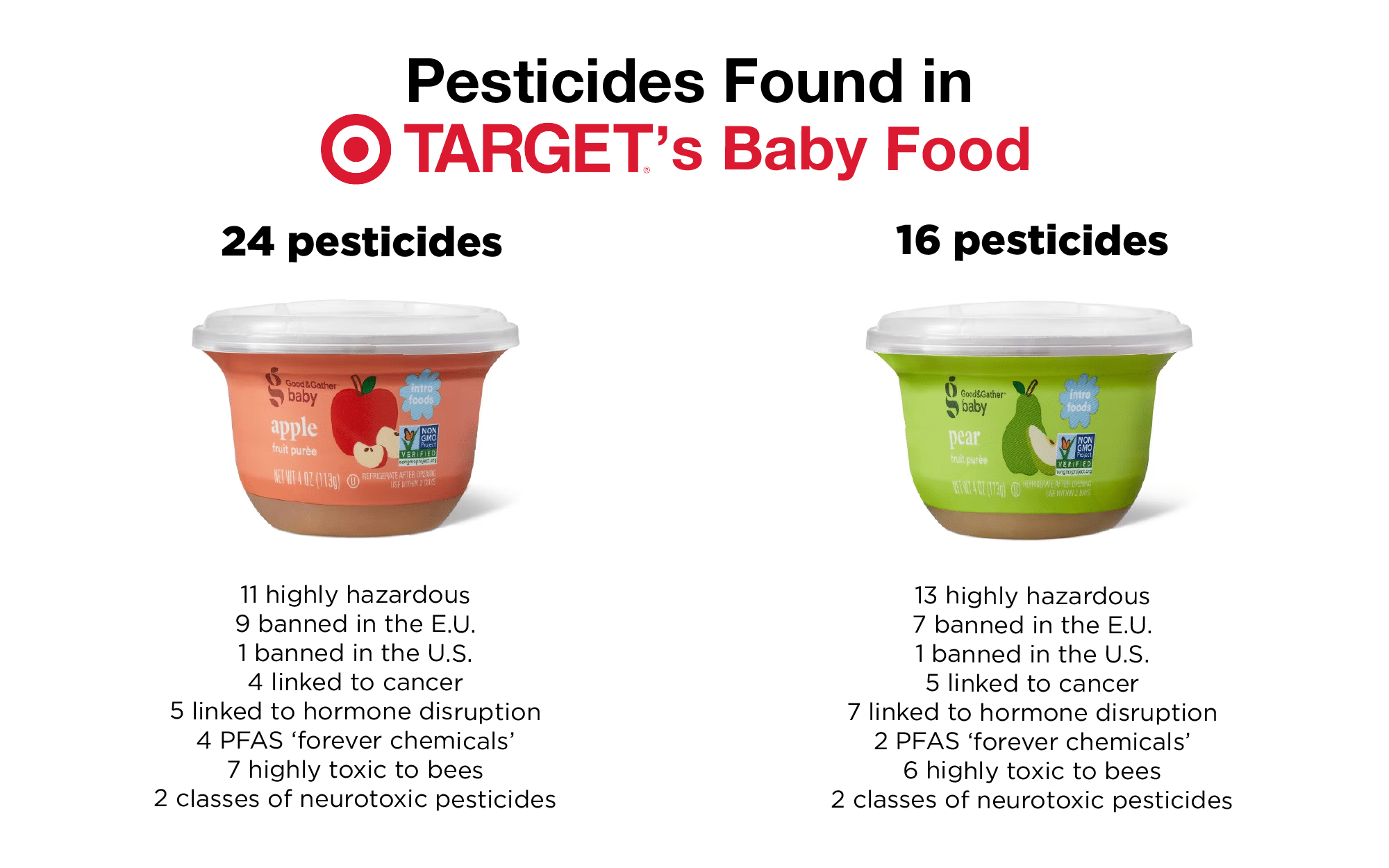
We Found Toxic Pesticides in Target’s Baby Food — Again.
In 2024, Friends of the Earth found a cocktail of toxic pesticides in two non-organic baby food products made by Target’s house brand, Good & Gather. A year later, we wanted to see if anything had changed. So we sent samples of the same Good & Gather products, Apple Fruit Purée and Pear Fruit Purée for babies, back to the lab.
What did we find? Even more pesticides – and even more highly hazardous pesticides – than the previous year. A parent sitting down to feed their baby with the most-polluted jar we tested would be unknowingly feeding their child 18 different pesticides.

Key Findings
We found a total of 29 pesticides in Target’s pear and apple baby food. Of those, 16 are classified as highly hazardous, 10 are banned in the European Union, 8 are linked to hormone disruption, and 6 are linked to cancer. We also found residues of two classes of neurotoxic pesticides. We found five pesticides that are PFAS ‘forever chemicals, one of which is banned in the U.S.
Decades of scientific research shows that pesticides can disrupt and derail the healthy functioning of our bodies. The term ‘pesticide’ encompasses insecticides, herbicides, and fungicides.
PFAS ‘forever chemicals’
Five of the pesticides we found meet the definition of PFAS: flonicamid, flubendiamde, fluopyram, novaluron, trifloxystrobin. One of these, flubendiamde, is banned in the U.S. These ‘forever chemicals’ do not break down in the environment and are associated with immune system suppression, liver damage, thyroid disease, reduced fertility, high cholesterol, obesity and cancer.
Carcinogens
Six of the pesticides we found in Target’s baby food products are classified by the U.S. Environmental Protection Agency (EPA) as “probable” or “likely” carcinogens. This includes chlorothalonil, which was present in two thirds of the baby food samples we tested, and thiabendazole, which was present in half the samples we tested. Childhood exposure to carcinogens is a mounting concern as rates of childhood and young adult cancer are increasing in the U.S.
Hormone Disrupters
Eight of the pesticides we found are linked to hormone disruption, also known as endocrine disruption. Extremely small amounts of endocrine disrupting chemicals – the equivalent to one drop in an Olympic-size swimming pool (one part per billion) – can block, mimic, or scramble the hormones that govern our reproductive, neurological, metabolic, and immune systems. Infancy is a time of particular vulnerability to the impacts of endocrine disruptors because babies’ bodies are in critical stages of development. The health effects of disrupting the endocrine system may not manifest until later in life. Endocrine disruptors are associated with increased risk of cancers, learning disabilities, brain development problems, birth defects, obesity, diabetes, and infertility and other reproductive disorders.
Neurotoxins
We found residues of two classes of neurotoxic pesticides in the baby food we tested – organophosphates and neonicotinoids. While these pesticides are highly concerning for their neurotoxicity, they are also linked to other serious health harms. Exposure to neurotoxic pesticides in early life, when children’s brains and nervous systems are still developing, is of particular concern.
Organophosphates
The breakdown products of organophosphate pesticides, known as metabolites, were found in all of the pear and apple baby food samples. Organophosphates are so toxic to children’s developing brains, even at extremely low levels of exposure, that scientists have called for a complete ban. They are associated with reduced IQ, attention disorders, delayed motor development, increased risk of learning disabilities, autism spectrum disorder, Alzheimer’s, Parkinson’s, hormone disruption, and cancer.
Neonicotinoids
We found neonicotinoid pesticides – including acetamiprid, clothianidin, and thiacloprid – in the samples of both the pear and apple baby food. Neonics have been linked to risk of autism spectrum disorder, impacts to the nervous system, endocrine disruption, and birth defects of the heart and brain.
Bees & Biodiversity
The same pesticides that are harmful to our health are also devastating for wildlife. Neonics are associated with great harm to pollinators and other insects; U.S. agriculture has become nearly 48x more toxic to insects since the introduction of neonics. The Environmental Protection Agency found that neonics are likely driving over 200 endangered species toward extinction. Organophosphates are toxic to wildlife, including pollinators, birds, and aquatic organisms like fish. Research shows that all classes of commonly used pesticides are harmful to soil life, which is the basis of a sustainable food system and farmers’ resilience to droughts and floods.
Why it Matters

Pesticides are designed to be poisons. The properties that make them toxic to insects and weeds can also make them toxic to us. Babies are particularly vulnerable to the harms of pesticides. Their brains and bodies are developing so rapidly that small exposures can result in lifelong impacts. Children also have greater exposure to pesticides than adults because they eat more per pound of their body weight than adults.

The most vocal advocates for a toxic-free food system are those on the frontlines of pesticide exposure: farmers, farmworkers, and other pesticide applicators who are exposed directly. The use of toxic pesticides in Target’s supply chain threatens farmer and farmworker safety and the health of rural communities.

The neonics and other pesticides found in Target’s baby food are damaging to the environment. Pesticides cause widespread harm to biodiversity above and below ground, including essential pollinators and the soil organisms that are at the heart of healthy soils. More than 40% of invertebrate pollinator species are facing extinction in the coming decades, in large part due to the use of toxic pesticides. Pesticides are also energy-intensive to produce, contributing to agricultural greenhouse gas emissions and fueling climate change.
The government’s pesticide policies are outdated and insufficient
The pesticides in Target’s baby food were detected at levels below the limits set by the U.S. Environmental Protection Agency (EPA). However, the standards set by the EPA are outdated, influenced by the powerful pesticide industry, and fail to account for the best and most recent science. Because the agency doesn’t follow the latest science, the EPA has failed to ban dozens of toxic pesticides that are outlawed in the European Union. Many scientists believe that the EPA’s standards are insufficient to protect people from the harmful impacts of pesticides in our diets.
Small amounts of pesticides matter to children’s health
Children’s developing brains and bodies are more vulnerable to the harms of pesticides; early exposure can impact children for life. Children consume more pesticides per pound of body weight and are less efficient at detoxifying pesticides. The latest science is clear that small exposures to pesticides can have significant impacts and that cumulative exposure from the many pesticides found in a typical non-organic diet can add up to harm children’s health.
Is organic worth it?
We all have the right to food that is free of harmful pesticides. Research shows that an organic diet rapidly and dramatically reduces our exposure to toxic pesticides. Organic farming also helps protect the farmers and farmworkers who grow our nation’s food from toxic exposures and helps regenerate the ecosystems that sustain all life. Science shows that diversified organic farming is regenerative and climate-smart: it protects soil health, sequesters more carbon, and improves farmers’ resilience to droughts and floods compared to conventional farming.
Target can help create a healthy, safe food system
With their enormous purchasing power, food retailers like Target can help create a healthy, sustainable, and just food system by offering more organic food, supporting government policies to help make organic food available for everyone, and phasing out the use of toxic pesticides in their non-organic supply chains.
Explore the Findings in Depth
Good & Gather Baby Pear Fruit Puree
| Pesticide | Percent of Samples Containing | Highly Hazardous | Banned in the E.U. | Probable / Likely Carcinogen | Endocrine Disruptor | Highly Toxic to Bees or Biodiversity | Average Amount of Pesticide Detected (ppb) |
| Acetamiprid | 66% | 9.6 | |||||
| Carbendazim | 66% | ✔ | ✔ | ✔ | 6.68 | ||
| Chlorantraniliprole | 66% | ✔ | ✔ | 12.39 | |||
| Chlorothalonil | 66% | ✔ | ✔ | ✔ | 97.16 | ||
| Clothianidin | 33% | ✔ | ✔ | ✔ | Trace | ||
| Emamectin-benzoate | 100% | ✔ | ✔ | Trace | |||
| Flubendiamide | 66% | ✔ | ✔ | ✔ | 3.03 | ||
| Myclobutanil | 33% | ✔ | ✔ | Trace | |||
| Novaluron | 33% | ✔ | 3.45 | ||||
| Propargite | 33% | ✔ | ✔ | ✔ | ✔ | Trace | |
| Pyrimethanil | 100% | ✔ | 121.22 | ||||
| Pyriproxyfen | 66% | Trace | |||||
| Spinetoram | 66% | ✔ | ✔ | ✔ | Trace | ||
| Spinosad* | 66% | ✔ | ✔ | Trace | |||
| Thiabendazole | 66% | ✔ | ✔ | ✔ | 101.08 | ||
| Thiophonate-methyl | 33% | ✔ | ✔ | ✔ | ✔ | Trace | |
| Organophosphate metabolites** | 100% | ✔ | ✔ | ✔ | ✔ | ✔ | 1,490 |
*Combination of spinosyn A & spinosyn B
** The presence of organophosphate (OP) metabolites indicates use of OPs in the supply chain for this product. The OP diazinon is widely used in apple and pear production in the U.S. and abroad; all of the chart categories are applicable to diazinon.
Good & Gather Baby Apple Fruit Puree
| Pesticide | Percent of Samples Containing | Highly Hazardous | Banned in the E.U. | Probable / Likely Carcinogen | Endocrine Disruptor | Highly Toxic to Bees or Biodiversity | Average Amount of Pesticide Detected (ppb) |
| Acetamiprid | 100% | 5.86 | |||||
| Boscalid | 33% | 3.03 | |||||
| Carbendazim | 33% | ✔ | ✔ | ✔ | Trace | ||
| Chlorantraniliprole | 66% | ✔ | ✔ | 2.34 | |||
| Chlorothalonil | 66% | ✔ | ✔ | ✔ | 9.89 | ||
| Cyprodinil | 33% | ✔ | ✔ | Trace | |||
| Difenoconazole isomer | 66% | 1.7 | |||||
| Emamectin-benzoate | 33% | ✔ | ✔ | Trace | |||
| Flonicamid | 33% | 1.18 | |||||
| Flubendiamide | 33% | ✔ | ✔ | ✔ | 3.4 | ||
| Fluopyram | 66% | Trace | |||||
| Methoxyfenozide | 33% | 3.04 | |||||
| Myclobutanil | 33% | ✔ | ✔ | Trace | |||
| Penconazole | 33% | Trace | |||||
| Pirimicarb | 33% | ✔ | ✔ | ✔ | Trace | ||
| Propargite | 33% | ✔ | ✔ | ✔ | ✔ | Trace | |
| Pyrimethanil | 100% | ✔ | 61 | ||||
| Spinetoram | 66% | ✔ | ✔ | ✔ | Trace | ||
| Tebuconazole | 66% | ✔ | ✔ | 1.49 | |||
| Tebufenozide | 33% | Trace | |||||
| Thiabendazole | 33% | ✔ | ✔ | ✔ | Trace | ||
| Thiacloprid | 33% | ✔ | ✔ | ✔ | Trace | ||
| Trifloxystrobin | 33% | Trace | |||||
| 2,4-D | 33% | ✔ | ✔ | 2.11 | |||
| Organophosphate metabolites** | 100% | ✔ | ✔ | ✔ | ✔ | ✔ | 91 |
*Combination of spinosyn A & spinosyn B
** The presence of organophosphate (OP) metabolites indicates use of OPs in the supply chain for this product. The OP diazinon is widely used in apple and pear production in the U.S. and abroad; all of the chart categories are applicable to diazinon.
Sources
For classification as highly hazardous pesticides, status as a U.S. EPA “probable” or “likely” carcinogen, and high toxicity to bees and biodiversity, see the Pesticide Action Network International List of Highly Hazardous Pesticides. For pesticides banned in the E.U., see the European Union’s Active Substances Database. For endocrine disruption, see the TEDX Database. For PFAS see the Minnesota Department of Agriculture, PFAS: Pesticide Active and Inert Ingredients. For organophosphate use in U.S. production of apples and pears, see the Pesticide Info Database.
Methods
Samples
Friends of the Earth purchased three samples of Good & Gather Pear Fruit Purée for babies and three samples of Good & Gather Apple Fruit Purée for babies from Target stores in California and Delaware in August 2025.
Lab
Lab tests were completed by The Health Research Institute. The Health Research Institute was established in 2017 and is a 501(c)3 non-profit laboratory which offers research, education, and service. It is a High Complexity CLIA Certified clinical laboratory and an ISO/IEC 17025: 2017 Accredited analytical laboratory.
Pesticide Multiresidue Test
This analytical method uses high performance liquid chromatography, linked to a triple quadrupole mass spectrometer (UPLC-MS/MS), to measure 220 of the most widely used and most egregious pesticides. UPLC-MS/MS analysis is considered the gold standard for pesticide analysis. The limit of quantitation of the method is 1 ppb (part per billion), which corresponds to detection of a 1/2 teaspoon of pesticide diluted into an Olympic swimming pool. The method that is accredited to the International Standards Agency’s ISO17025 standard, which is respected globally.
Test for Organophosphate Metabolites
This analytical method uses high performance liquid chromatography, linked to a triple quadrupole mass spectrometer (UPLC-MS/MS), to measure the presence of metabolites of organophosphate pesticides with high sensitivity and high specificity. With this method it is possible to screen simultaneously for the full range of organophosphate pesticides in a single test. This method has a limit of quantitation of 1.0 ppb.